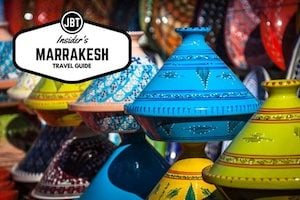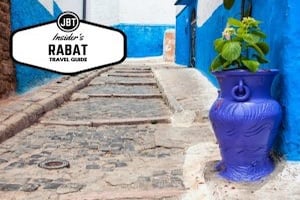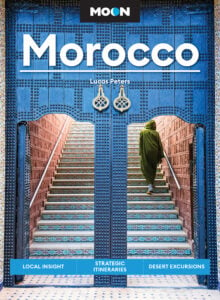
When I was planning a trip to Fez a few weeks ago, I made sure to book a riad (a traditional Moroccan house) with air conditioning. Like many parts of Morocco in July, the temperature was forecast to be almost 104 degrees Fahrenheit (40 Celsius). I was sweating as I walked through the streets but was pleasantly surprised to find that my guesthouse was nice and cool… and they hadn’t even turned on the AC! This was all thanks to the genius of Moroccan architecture!
Most Moroccan architecture is designed with the climate in mind. Riads, like the one I was staying in, consist of an open central courtyard to help with ventilation and have thick walls that help keep out heat. Rooms are located around the middle area and typically don’t have windows that open to the outside. Many western tourists may find this unsettling. However, it helps regulate temperature given that about 30% of unwanted heat enters through windows.
Ksars: The Original Moroccan Architecture
In the south of Morocco near the Sahara desert, where temperatures often soar past 115 degrees Fahrenheit (45 Celsius) in the summer, traditional villages made up of attached homes, called ksars, are made from mud bricks and rammed earth. It is the material that is best-suited to the warm and dry climate, according to Eliana Baglioni from Florence University and her colleagues in a recent research paper, and is also one of the few natural building resources available in the area.
Ksars incorporate many features that help its inhabitants stay cool. First and foremost, their compact structure, where individual homes are connected by shared walls, reduces exterior surfaces and thus protects against extreme weather.
Ksar Tisergat, located 7 km to the north of the town of Zagora in the Draa valley and which is still inhabited. It is a good example of traditional Moroccan architecture and demonstrates several other techniques as well, says researcher Adil Moumane, a Zagora resident. “Its position beside an oasis protects it from the heat as well as sandstorms.” In addition, Ksar Tisergat has high walls and covered walkways that provide shade.

Most ksars have flat roofs – an invaluable part of the living space in the summer when people sleep outdoors due to the heat. The surface is protected with a coating called a dess that helps it to resist cracking in high temperatures. Coarse earth – or a mixture of river sand, gravel and lime – are packed together in a layer no more than a foot (30 centimeters) thick, with some areas sloping gently for water drainage.
Before refrigerators, preserving food in hot weather was another challenge. Meat and vegetables, particularly those used in couscous, were often dried on the roof to make them last longer. At Ksar Tisergat, there are food storage rooms in individual dwellings. According to locals, says Moumane, dates kept in large clay pots in these rooms can last for over six years as subsistence in times of drought.

Although earth homes are ideal for the desert climate, they must be regularly maintained. This can be costly and time-consuming. It is no surprise that many ksars have been abandoned.
As the country develops, new homes are built from concrete even though it isn’t as well-suited to environmental conditions and hot climes of the south. As a result of this development, knowledge of traditional building techniques is being lost. The last ksars were thought to be built about 500 years ago by maalems – artisans who took on both the role of architect and foreman – and would orally pass on skills to younger generations. Since ksars have to be restored and maintained every year, people living in them retained the knowledge. But now that’s changing. There are just a few remaining elderly people with the expertise. “Unfortunately, most of the new generation has never lived in a ksar and doesn’t even understand the purpose of traditional building techniques,” says Moumane.
Although some traditional ksars are being restored, Moumane thinks that more needs to be done. He suggests recruiting the older generation to take part or perhaps getting them to build a ksar that becomes a museum documenting the process. In addition to making sure a part of history isn’t lost forever, the local know-how could be invaluable for tackling climate change. “Today we are seeing heatwaves all over the world so this knowledge can be useful for other places, not just the desert.”
When wandering through the old medina of Fez, I thought back to my talk with Moumane, the ksars of the desert and the great origin of Moroccan Architecture. The buildings of the desert were once adopted to great cities like Fez. This is obvious as you wonder through the city and see it as a giant ksar. These days, it seems like it is the architecture of the cities influencing the desert. But at what cost? Sometimes what is most natural is most good. It’s unlikely that Morocco will start building ksars and medinas as they did hundreds of years ago. However, packed with a little knowledge of the genius of the original Moroccan architecture and understanding its basic concepts might help us to appreciate it even more in this era of climate change and, dare I say, maybe adapt some of its best concepts.
About the Author
 Sandrine Ceurstemont is a freelance science writer currently based in Morocco. Her interests range from bizarre animal behaviour to the unknowns of the vast world underwater to new robots. Since living in Morocco, she has become interested in local innovations and has written about one of the world’s largest solar power plants in Ouarzazate. She frequently writes for New Scientist and the BBC.
Sandrine Ceurstemont is a freelance science writer currently based in Morocco. Her interests range from bizarre animal behaviour to the unknowns of the vast world underwater to new robots. Since living in Morocco, she has become interested in local innovations and has written about one of the world’s largest solar power plants in Ouarzazate. She frequently writes for New Scientist and the BBC.







